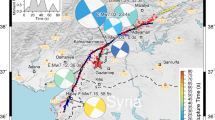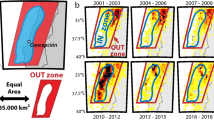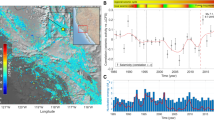Abstract
We determined the duration of high-frequency energy radiation from Indonesia's great Sumatra–Andaman earthquake (26 December 2004) to be about 500 seconds. This duration can be translated into a rupture length of about 1,200 km, which is more than twice as long as that inferred from body-wave analyses performed soon after the event. Our analysis was able rapidly to define the extent of rupture, thereby aiding the assessment of seismic hazard in the immediate future.
Similar content being viewed by others
Main
Soon after the Sumatra–Andaman earthquake, seismic body-wave studies in the period range of 10 to 50 s indicated that there had been a slip distribution over a 400-km segment1,2,3 (Fig. 1a). These methods for rapid assessment of major earthquakes rely on the extended P-wave train to deduce the source rupture pattern. But when an event lasts longer than the period between the later-phase PP and P waves, a problem arises in determining the source duration.
a, Rupture-termination points of the earthquake estimated from body-wave inversion (blue square) and from high-frequency radiation (red square) calculations; green square, candidate for termination point (see supplementary information). Red star, earthquake epicentre; circles, aftershock locations; black stars, locations of large foreshocks and aftershocks. b, Typical teleseismic seismograms (broadband) showing P waves before (top) and after (bottom) high-bandpass (2–4 Hz) filtering; later phases are removed by attenuation. D=64 degrees. c, Enveloped high-frequency seismogram comparing the main shock (red) with smaller events (orange) at the same station. d, Smoothed envelopes (2–4-Hz bandpassed) of the main shock as a function of azimuth (horizontal angle): shorter wave trains are evident in the direction of rupture (azimuth about 340°). Red dots, estimated end of the source duration.
Figure 1b shows the observed displacement seismogram for a seismic event of magnitude 7.1 (which occurred near the epicentre of the 26 December earthquake (Fig. 1a, red star) on 2 November 2002). The phases PP and PPP are apparent, but are seen to disappear at high frequency (in the range 2 to 4 Hz) because of attenuation in the Earth's mantle4. We therefore analysed high-frequency radiation from the Sumatra earthquake by determining amplitude–time envelopes and smoothing them as described4 (see supplementary information). Comparison of the smoothed envelopes for the main shock of this event with three smaller fore- and aftershocks shows that the amplitude and duration of the main shock are much larger (Fig. 1c).
Figure 1d plots the envelopes for the main shock as a function of azimuth (angular distance from the horizon). Each envelope shows a short rise time, then a relatively flat, sustained portion, which is followed by rapid decay. The envelope duration (red dots in Fig. 1d) reveals a clear azimuthal pattern of 400 s in the direction of rupture (at about 340°) to 590 s in the opposite direction. We assume that these high-frequency signals are derived mostly from the rupture front5. From the range of the azimuthal variation in duration (190 s), we determine the rupture length to be 1,200 km — the longest ever recorded. Then, from the average duration (about 500 s), we can derive the average rupture speed as 2.5 km s−1.
The rupture length is comparable to the length of the aftershock distribution (Fig. 1a). The rupture was substantially longer than that of the 1960 great Chilean earthquake6 (340 s), and had a larger magnitude of 9.5, but the tectonic setting at Sumatra is very different from that at Chile. In Chile, the age of the subducting plate is young (15 million years old) and the plate convergence is nearly normal to the trench, whereas in Sumatra the subducting plate is older (more than 60 million years old) and the plate convergence is oblique, especially in the north. This difference could be responsible for the difference in slip behaviour between the two events, and hence the disparities in rupture length and magnitude.
The high-frequency radiation reflects only the propagation of the rupture front, so it alone cannot uniquely determine the slip distribution. Modelling of long-period surface waves and normal modes will eventually constrain the spatiotemporal distribution of slip. Despite such uncertainty, our simple analysis at high frequency provides an accurate and rapid determination of the duration and rupture length of this earthquake, which are important for rapid assessment of immediate seismic hazard in the area.
References
Yamanaka, Y. http://www.eri.u-tokyo.ac.jp/sanchu/Seismo_Note/
Yagi, Y. http://iisee.kenken.go.jp/staff/yagi/eq/Sumatra2004/Sumatra2004.html
Shearer, P. M. & Earle, P. S. Geophys. J. Int. 158, 1103–1117 (2004).
Madariaga, R. Ann. Geophys. 1, 17–23 (1983).
Houston, H. & Kanamori, H. Bull. Seismol. Soc. Am. 76, 19–42 (1986).
Author information
Authors and Affiliations
Corresponding author
Ethics declarations
Competing interests
The authors declare no competing financial interests.
Supplementary information
Rights and permissions
About this article
Cite this article
Ni, S., Kanamori, H. & Helmberger, D. Energy radiation from the Sumatra earthquake. Nature 434, 582 (2005). https://doi.org/10.1038/434582a
Published:
Issue Date:
DOI: https://doi.org/10.1038/434582a
This article is cited by
-
Spatiotemporal analysis of OLR as a precursory signature of seismic nucleation process in Sumatra region
Environmental Earth Sciences (2024)
-
A Numerical Study of SMART Cables Potential in Marine Hazard Early Warning for the Sumatra and Java Regions
Pure and Applied Geophysics (2023)
-
Imaging of rupture process of 2005 Mw 7.6 Kashmir earthquake using back projection techniques
Arabian Journal of Geosciences (2022)
-
Displacements Before and After Great Earthquakes: Geodetic and Seismic Viewpoints
Pure and Applied Geophysics (2021)
-
Twenty-Five Years of Progress in the Science of “Geological” Tsunamis Following the 1992 Nicaragua and Flores Events
Pure and Applied Geophysics (2019)
Comments
By submitting a comment you agree to abide by our Terms and Community Guidelines. If you find something abusive or that does not comply with our terms or guidelines please flag it as inappropriate.




